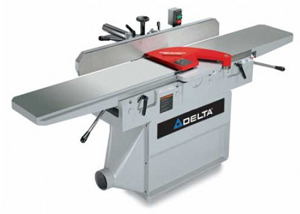
I recently read your response to a question about which jointer, 6″ or 8″, to buy. I currently have a 6″ jointer that I hate, mainly because the infeed and outfeed tables are too small, but I also am always limited to 6″ in width and, since I buy all of my lumber roughsawn, this is a limiting factor on a lot of projects. I now have the ability to upgrade to a larger jointer and luckily can go to an 8, 10, or 12″ jointer. All three are 84 or 96″ in length which will help dramatically, but are the 10″ and 12″ overkill? I have a 600 square foot shop and build furniture as a part-time hobby that I hope to turn into something more in the future. Will I get much extra use out of the larger machines? – Jason
Tim Inman: Although it is possible to flatten and surface the face of a 12-inch board on a 12-inch jointer, there are very few reasons why one might actually want to do that. For furniture work, especially, stability is always an overriding issue. Typically, wide boards are ripped into narrow ones, rearranged, and glued together to form a more stable substrate when a wide board is needed. To use a 12-inch board as a one-piecer is asking for warping and cupping troubles later on. I’d suggest you stay with the 6-inch jointer and add a benchtop surface planer in a shop as small as 600 square feet. I’d think you would get a lot more use from the surface planer/jointer combination. Though the “proper” sequence is to flatten the surface of the board on the jointer, then go to the planer for the other side, reality is different. Principles and practices are often not the same thing. In nearly every shop I’ve ever worked in or around (and that’s a lot of ’em) I can count the times I’ve seen that “correct” jointer-to-planer process performed on one hand. It just isn’t profitable to do it the “right” way — and the results are indistinguishable in almost every case. If you’re making period reproductions, then we might need to have a different discussion….
Chris Marshall: Originally, your idea of a really wide jointer purchase really got me to dreaming, but in the end, I agree with Tim here. A huge jointer probably is more expense than it’s worth these days for typical hardwood lumber that is often not more than 8 in. wide. I do exactly what Tim points out in his example: I rip wide lumber into narrower pieces that fit the bed of my 8-in. jointer so I can flatten their first reference faces. Then I’ll run them through my planer, joint the mating edges and glue the pieces back together again. If I use a band saw for the ripping step and match the pieces up carefully before re-gluing, the grain pattern blends in so well that I have difficulty finding the glue lines. Of course, if you bought a 10- or 12-in. machine, you might be able to expedite your surfacing process by skipping the ripping/regluing approach, but the board might not stay flat in the end anyway. Ultimately, you’ll use whatever width jointer you buy over and over again, and the larger machines will offer more bed capacity. But 8-in. machines “rule the roost” of most hobbyist shops these days — and for good reason. They’re practical, affordable and for the most part, sufficient for what we need them to do.







